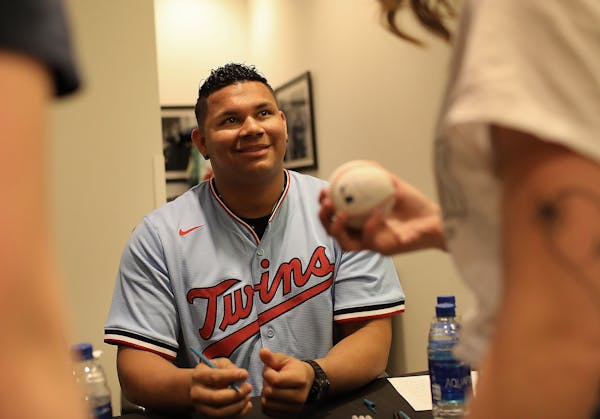As they hold TwinsFest at Target Field this weekend, the Twins have already achieved one of the most stunning accomplishments in American sports, one almost unimaginable in its audacity and execution.
They once again persuaded baseball players from Central America and the sunniest regions of the United States to fly to Minneapolis in January, where they jumped into vans and buses to tour the Upper Midwest.
"Yeah, Jose, all we want you to do is fly from Puerto Rico to Minneapolis, then drive to Fargo and back, so you can meet the fans who may someday boo you.''
It's a package deal: air travel, road travel, bitterly cold weather and public interrogation. Somehow, the Twins get most of their players to show up most of the time for their winter events. Now the team is pushing to get every Minnesotan into Target Field this summer.
Last year, while conducting a series of interviews for a profile, I took a tour of the ballpark with Twins President and CEO Dave St. Peter. He greeted ushers by name and, as we reached the gate in right field, he worried aloud that Major League Baseball was pricing less affluent fans out of the ballpark experience.
It's an easy problem to lament and a hard one to solve, but St. Peter is trying. The Twins have unveiled the Twins Ballpark Pass. For prices as low as $45 a month, a fan can attend every game with standing-room-only tickets.
I usually don't spend much time on local teams' ticket prices, but this plan hits me where I lived, and live.
As a kid, my parents usually bought the cheapest possible tickets. We'd sit in the bleachers and buy hot dogs and pop with pocket change, and those experiences made me a lifelong baseball fan.
This plan would meet my adult preferences, too. I lived in downtown Minneapolis for most of the past decade, and when I attended a Twins game, it was usually by buying the cheapest seat available, then walking around the concourse or finding a place to stand. Target Field is best experienced from a variety of vantage points.
The Twins' new plan means you can watch a big-league team that won 101 games last year by spending less per ticket than some people spend per coffee.
This is not charity. St. Peter knows that baseball needs to connect with kids and young families. The game needs to justify itself to a new generation, and baseball on a TV screen cannot compete with baseball as an in-person sensory experience.
"Organizationally, there's a recognition that some of our traditional ticket packages, while they're very popular and offer great seats and wonderful value in my mind, they frankly might not be reachable for the average fan,'' St. Peter said Friday after the team announced that Justin Morneau will be enshrined in the team's Hall of Fame. "Frankly, any fan that lives in a household that may be lower income has no shot. I think for us to push towards 3 million in attendance, we have to be accessible to all fans. And one of the ways we can do that is to make a concerted effort to create more affordable options around our season tickets, around our single-game tickets, and also around concessions.
"We introduced two family concession stands here last year. You walk through, you get a Bud Light for five bucks, a water for two bucks, a hot dog for $2, and guess what? It didn't negatively impact our revenue from an overall ballpark concessions standpoint.''
If you want to be known as a family game, you have to have prices that appeal to families.
"I believe we can do both,'' St. Peter said. "We can maximize revenues on the top end based on the traditional method, but I think we have to be more aggressive on the other end, to try to bring additional people into the queue. Ultimately that's how we go from 2 million in attendance to hopefully north of 3 million.''
Jim Souhan's podcast can be heard at TalkNorth.com.

Souhan: This is KAT's chance to prove Flip Saunders was right

Souhan: Why Tiger Woods should keep swinging
Souhan: Scheffler wins Masters again, shows what makes him special
Morikawa falters in final round at Masters


